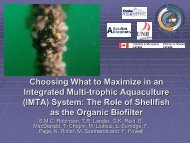Integrated multi-trophic aquaculture (IMTA) in marine temperate waters
Integrated multi-trophic aquaculture (IMTA) in marine temperate waters
Integrated multi-trophic aquaculture (IMTA) in marine temperate waters
Create successful ePaper yourself
Turn your PDF publications into a flip-book with our unique Google optimized e-Paper software.
<strong>Integrated</strong> <strong>multi</strong>-<strong>trophic</strong> <strong>aquaculture</strong> (<strong>IMTA</strong>) <strong>in</strong> mar<strong>in</strong>e <strong>temperate</strong> <strong>waters</strong> 35<br />
of the algal nutrient biofilter Gracilaria, environmental costs of waste discharges are<br />
significantly reduced and profitability is significantly <strong>in</strong>creased (Chop<strong>in</strong> et al., 2001).<br />
The <strong>in</strong>troduction of a nutrient tax, or its exemption through the implementation of<br />
biomitigative practices, would make the economic demonstration of the validity of the<br />
<strong>IMTA</strong> approach even more obvious. Moreover, by implement<strong>in</strong>g better management<br />
practices, the <strong>aquaculture</strong> <strong>in</strong>dustry should <strong>in</strong>crease its social acceptability, a variable to<br />
which it is very difficult to give a monetary value, but an imperative condition for the<br />
development of its full potential. Reduc<strong>in</strong>g environmental and economic risk <strong>in</strong> the<br />
long term should also make f<strong>in</strong>anc<strong>in</strong>g easier to obta<strong>in</strong>.<br />
Lift<strong>in</strong>g fish farm moratoria on the condition that biomitigative practices such as<br />
<strong>IMTA</strong> are implemented<br />
Many countries (e.g. Norway, Sweden and South Africa) have moratoria on the<br />
further expansion of fish farms. This could limit the immediate development of<br />
<strong>IMTA</strong>. However, as the positive benefits of this type of culture system become further<br />
known from the work of academic and <strong>in</strong>dustry pioneers <strong>in</strong> this field (e.g. Canada),<br />
it is likely those other countries will also adopt this practice. The adoption of <strong>IMTA</strong><br />
may allow the further expansion of <strong>aquaculture</strong> farms and economic opportunities<br />
<strong>in</strong> coastal regions due to the susta<strong>in</strong>ability and ecological balanc<strong>in</strong>g of this type of<br />
production system. Therefore, to ensure further expansion of <strong>aquaculture</strong>, countries<br />
could consider lift<strong>in</strong>g the moratoria on fish farms, on the condition that they show<br />
<strong>in</strong>itiative towards susta<strong>in</strong>able development, through biomitigation, as is already the<br />
case <strong>in</strong> Sweden (L<strong>in</strong>dahl et al., 2005).<br />
Putt<strong>in</strong>g <strong>in</strong> place enabl<strong>in</strong>g legislation for commercialization of <strong>IMTA</strong> products<br />
For <strong>IMTA</strong> to develop to a commercial scale, appropriate regulatory and policy<br />
frameworks need to be put <strong>in</strong> place. Present <strong>aquaculture</strong> regulations and policies are<br />
often <strong>in</strong>herited from previous fishery frameworks and reason<strong>in</strong>g, which have shown<br />
their limitations. To develop the <strong>aquaculture</strong> of tomorrow, the present <strong>aquaculture</strong><br />
regulations and policies need to be revisited. Adaptive regulations need to be<br />
developed by regulators with flexible and <strong>in</strong>novative m<strong>in</strong>ds, who are not afraid of<br />
putt<strong>in</strong>g <strong>in</strong> place mechanisms that allow the test<strong>in</strong>g of <strong>in</strong>novative practices at the R&D<br />
level, and, if deemed promis<strong>in</strong>g, mechanisms that will take these practices all the way<br />
to C (commercialization). As the <strong>IMTA</strong> concept cont<strong>in</strong>ues to evolve, it is important<br />
that all sectors of the <strong>in</strong>dustry be aware of the implications of the changes <strong>in</strong>volved<br />
so that they can adapt <strong>in</strong> a timely and organized manner. To move research from the<br />
“pilot” scale to the “scale up” stage, some current regulations and policies may need<br />
to be changed or they will be seen as impediments by <strong>in</strong>dustrial partners who will see<br />
no <strong>in</strong>centive <strong>in</strong> develop<strong>in</strong>g <strong>IMTA</strong>. For example, an earlier version of the Canadian<br />
Shellfish Sanitation Program (CSSP) prevented the development of <strong>IMTA</strong> because of<br />
a clause that specified that shellfish could not be grown closer than 125 m of f<strong>in</strong>fish<br />
net-pens. This paragraph was never written with <strong>IMTA</strong> <strong>in</strong> m<strong>in</strong>d, but it imp<strong>in</strong>ged<br />
seriously its development. After four years (2004-2008), it has f<strong>in</strong>ally been amended so<br />
that <strong>IMTA</strong> practices can legally develop to commercial scale based on recent, reliable<br />
and relevant data and <strong>in</strong>formation provided by the <strong>IMTA</strong> project <strong>in</strong> the Bay of Fundy<br />
and similar projects <strong>in</strong> other parts of the world. While four years may appear to be<br />
a long period of time for some, it is a relatively short delay when one recognizes the<br />
regulations and legislations that needed to be reviewed and considered through such<br />
governmental type processes <strong>in</strong>volv<strong>in</strong>g several federal and prov<strong>in</strong>cial departments.<br />
However, when develop<strong>in</strong>g a new <strong>aquaculture</strong> practice <strong>in</strong> a particular country,<br />
regulatory issues should be addressed right from the beg<strong>in</strong>n<strong>in</strong>g to avoid delays when<br />
new products are ready to go to market.



